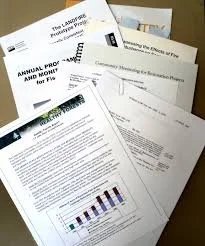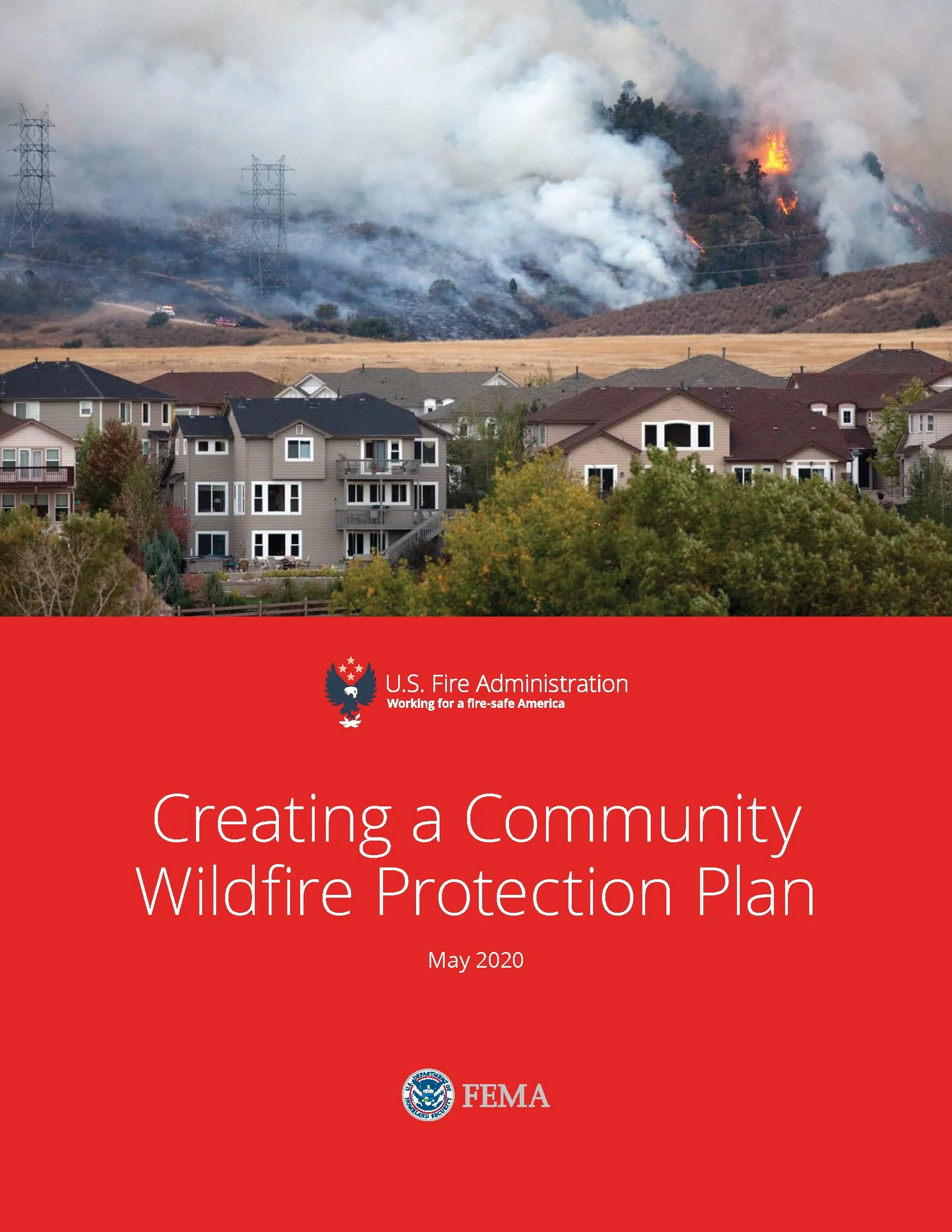Hello and happy Wednesday!
In autumn of 2022, the US Forest Service announced the creation of Community Wildfire Defense Grants (CWDG). This funding is intended to help at-risk local communities and Tribes plan and reduce wildfire risk by prioritizing at-risk, low-income, disaster-impacted communities. A key requirement for CWDG eligibility is the possession of a Community Wildfire Protection Plan (CWPP) for the intended geographic area. For communities just beginning the process of wildland fire hazard planning, creating a CWPP can act as both a roadmap for action and a huge first hurdle to getting started.
This week’s blog offers resources to learn about the history of CWPPs, the key elements for inclusion in a plan, suggestions for forming a collaborative and jumping into the CWPP writing process, and an invitation to attend a CWDG listening session to learn about and inform future CWPP implementation funding opportunities.
Today’s Wildfire Wednesday features information on:
CWPPs: the basics
A listening session series on CWDG funding
The FAC NM spring webinar series, beginning today (1/18) at 2pm MST!
Upcoming webinars from the SW Fire Science Consortium
Take care and stay warm,
Rachel
Community Wildfire Protection Plans
Where it began: the Healthy Forest Restoration Act
In 2001, the National Fire Plan legislation brought renewed focus on engaging communities in federal wildfire mitigation efforts. As a result, the Healthy Forests Restoration Act of 2003 (HFRA) directed the Secretary of Agriculture (National Forest System lands) and the Secretary of the Interior (Bureau of Land Management lands) to plan and conduct hazardous fuel reduction projects on Federal lands. HFRA focuses attention on four types of land:
The wildland-urban interfaces (WUI) of at-risk communities,
At-risk municipal watersheds,
Where threatened and endangered species or their habitats are at-risk to catastrophic fire and where fuels treatment can reduce those risks, and
Where windthrow or insect epidemics threaten ecosystem components or resource values.
The legislation contains a variety of provisions aimed at expediting the preparation and implementation of hazardous fuels reduction projects on federal land and assisting rural communities, States and landowners in restoring healthy forest and watershed conditions on state, private and tribal lands. Through this language, the bill encourages communities to go through the collaborative process of planning, prioritizing and implementing hazardous fuel reduction projects, ultimately resulting in community wildfire protection plans (CWPPs) to reduce their wildland fire risk and promote healthier forested ecosystems.
Communities who have developed CWPPs have done so using many different processes, resulting in plans with varied form and content. Due to the vagueness of the legislative language, communities have the freedom to develop CWPPs that are relevant to their local conditions and allows for the development of resource capacities that communities are using to produce diverse plans that build on local context to achieve broad policy goals of wildfire hazard reduction.
Read a summary of implementation actions enabled through the HFRA and how the bill’s language has enabled flexibility with authoring and customizing CWPPs.
Elements of a Community Wildfire Protection Plan
“Community Wildfire Protection Plans have become the primary mechanism for evaluating risk due to their emphasis on community involvement and assessment of local resources. CWPPs are also an important planning document used by emergency responders and citizens to plan for and respond to wildfire emergencies. Local leaders and governmental entities find CWPPs valuable for the purposes of identifying critical needs and prioritizing funding” (NM EMNRD, 2021).
A CWPP has five main sections:
Community Risk Ratings
Priority Fuel Reduction (vegetation treatments)
Priority Actions (evacuation planning, education outreach, etc.)
Reduction of Structural Ignitability
Adoption and Signatures
Community Risk Ratings
Risk ratings are specific to distinct communities. They are usually calculated using a computer-based (GIS) wildfire risk model and must be categorized as either high, medium, or low. Models may include a number of different risk factors, each given a weight which corresponds to their importance, such as:
Fuel hazards (vegetative fuels present)
Risk of wildfire occurrence (locations of previous wildfires)
Essential infrastructure at risk (homes, businesses, power, communication facilities, etc.)
Other community values at risk (areas with scenic, recreational, economic or cultural value)
Local preparedness and firefighting capability (road access, distance from fire stations, distance from water sources)
Where appropriate, these ratings should reflect and align with national Wildland Urban Interface (WUI) objectives and goals.
Priority Fuel Reduction
A CWPP must identify and prioritize areas for hazardous fuel reduction treatments and recommend the types and methods of treatment that will protect one or more at‐ risk communities and essential infrastructure. This identification will likely be based on a combination of community risk ratings and social and economic values (tourism hot spots, areas of cultural importance, business hubs, etc.). Prioritizing fuel reduction creates a collaborative map for which areas will receive treatment in what order and why.
Priority Actions
After identifying the areas at greatest risk and greatest need for action, the next step in developing a CWPP is to select community wildfire risk reduction priorities. These actions may include fuel treatments, restoration projects, outreach and education, evacuation planning, and more.
Reduction of Structural Ignitability
In additional to priority fuel reduction projects and risk reduction priorities, a CWPP should identify actions that homeowners, residents, and communities can take to reduce the ignitability of structures throughout the area. This part of the plan may include guidelines for home hardening, creation of defensible space, and funding mechanisms for this work throughout high-priority communities.
Adoption and Signatures
The HFRA requires local governments, local fire department(s) and the state entity responsible for forest management (EMNRD) to sign off on the final contents of a CWPP. Additional signatories on your CWPP may include collaborators involved in the creation of the plan and key individuals from communities which will be impacted.
Other important CWPP elements may include a 1-2 year Action Plan, accomplishments since the last CWPP (for plan updates), and WUI Mapping, Hazard Mapping, and lots of spatial analysis.
Upcoming Opportunities
Spring FAC NM Webinar Series
Fire Adapted New Mexico is kicking off its spring webinar series with an informational presentation by Gabe Kohler of the Forest Stewards Guild on FAC NM’s new membership structure.
January 18 @ 2pm MST: Revitalizing Membership in FAC NM
An interactive webinar on the network’s revitalized membership structure and improved tools, resources, and facilitation for peer-to-peer knowledge exchange. This presentation will cover new levels of involvement in the learning network, upcoming workshops and grants available to members, and future plans for network growth and other continual learning opportunities.
Keep an eye on the FAC NM Events webpage for announcements and registration for our mid-March and mid-May webinars!
Community Wildfire Defense Grant (CWDG) Webinars
What: The CWDG Program will conduct a series of Listening Sessions to solicit feedback and comments on the program and provide opportunities to share recommendations for how to improve CWDG in the future.
When: January 18th, 19th, 20th and 26th.
There are Listening Sessions scheduled for each of four Notice of Funding Opportunities, but you may to attend whichever Listening Session suits your schedule.
Sign up through the Wildland Fire Learning Portal by enrolling in the 2023 Community Wildfire Defense Grant (CWDG) Listening Sessions course, or visit this link: https://wildlandfirelearningportal.net/course/view.php?id=1908
Southwest Fire Science Consortium Monthly Webinars
January 31 @ 3pm MST: Wildfire and Climate Change Adaptation of Western North American Forests: A Case for Proactive Management
Three experts will tell the story of forest change since colonization, and share insights and answer questions about how we might steward a legacy of forest change and mitigate climate change impacts. Following their presentations, the speakers will lead a discussion on reframing management direction and current barriers to increasing the pace and scale of forest adaptation.






